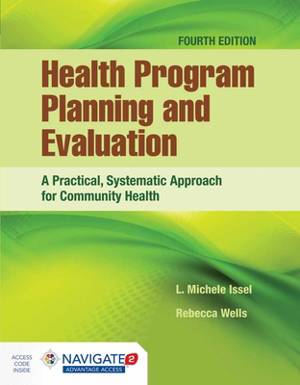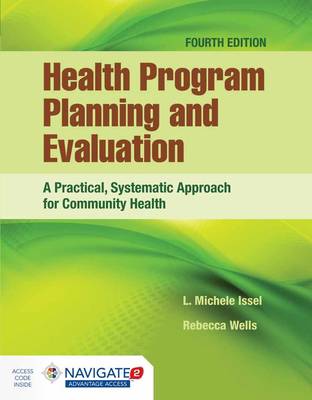
- Retrait gratuit dans votre magasin Club
- 7.000.000 titres dans notre catalogue
- Payer en toute sécurité
- Toujours un magasin près de chez vous
- Retrait gratuit dans votre magasin Club
- 7.000.000 titres dans notre catalogue
- Payer en toute sécurité
- Toujours un magasin près de chez vous
Health Program Planning and Evaluation: A Practical, Systematic Approach for Community Health
A Practical, Systematic Approach for Community Health
L Michele Issel, Rebecca Wells
Livre broché | Anglais
97,95 €
Description
Selected by Doody's Review Services as one of Doody's Core Titles in Public Health, Health Program Planning and Evaluation, Fourth Edition carefully walks the reader through the process for developing, implementing, and evaluating successful community health promotion programs. Featuring reader-friendly, accessible language and practical tools and concepts, this outstanding resource prepares students and professionals to become savvy consumers of evaluation reports and prudent users of evaluation consultants. The Fourth Edition reflects the major changes in the field of community health with updated examples and references throughout. New to this Edition: - Introduction of the concept of root causes as social determinants. - A comprehensive description of how each target setting option relates to the corresponding level of the health impact pyramid. - More information on informatics and big data as related to program planning and monitoring - A discussion of photos and video as modes of data collection. - A reinforcement of informatics, photos and big data as useful in program evaluation - Current terminology of first and second order coding of qualitative data. The following is a list of chapter specific major, substantive revisions evident in the 4th edition, beyond general updating of references: - Combined Chapters 3 and 4 in order to tighten and shorten the content. Only currently used planning tools will be presented, and greater content on workforce planning will be added. We will increase the emphasis asset-based and strengths based approaches to assessment and planning. We will also discuss the relevance of the ACA to community assessment. - Chapter 4: Introduce the concept of root causes as social determinants. - Chapter 8: Provide a strong description of how each target setting option relates to the corresponding level of the health impact pyramid. - Move Chapter 9 into Section III Health Program Development, and revise wording to reflect that the information is part of the development phase. - Chapter 10: increase the content on informatics and big data as related to program planning and monitoring. Revise the exhibit to show the budge on an excel sheet. - Chapter 11: include discussion of photos and video as modes of data collection. - Chapter 15: reinforce informatics, photos and big data as useful in program evaluation - Chapter 16: revise to reflect current terminology of first and second order coding of qualitative data. We will also frame case study as a mixed method rather than a strictly qualitative method
Spécifications
Parties prenantes
- Auteur(s) :
- Editeur:
Contenu
- Nombre de pages :
- 428
- Langue:
- Anglais
Caractéristiques
- EAN:
- 9781284112115
- Date de parution :
- 17-08-17
- Format:
- Livre broché
- Format numérique:
- Trade paperback (VS)
- Dimensions :
- 178 mm x 226 mm
- Poids :
- 708 g







